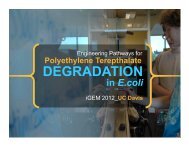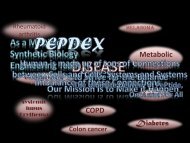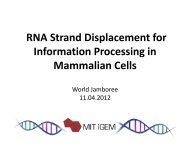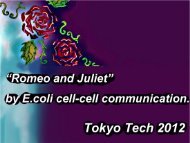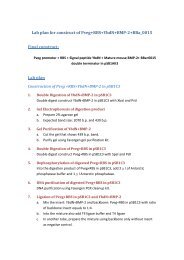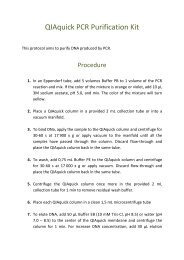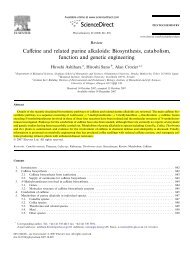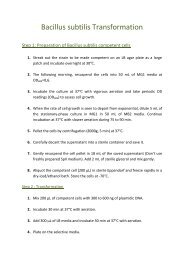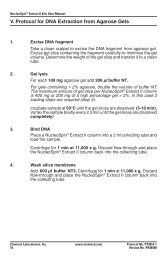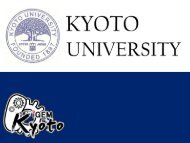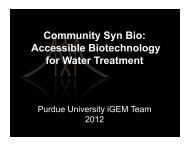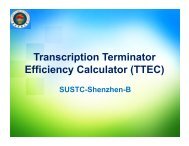QIAquick PCR Purification Kit Protocol - iGEM 2012
QIAquick PCR Purification Kit Protocol - iGEM 2012
QIAquick PCR Purification Kit Protocol - iGEM 2012
Create successful ePaper yourself
Turn your PDF publications into a flip-book with our unique Google optimized e-Paper software.
<strong>QIAquick</strong> <strong>PCR</strong> <strong>Purification</strong> <strong>Kit</strong> <strong>Protocol</strong><br />
using a microcentrifuge<br />
This protocol is designed to purify single- or double-stranded DNA fragments from <strong>PCR</strong><br />
and other enzymatic reactions (see page 8). For cleanup of other enzymatic reactions,<br />
follow the protocol as described for <strong>PCR</strong> samples or use the MinElute Reaction Cleanup<br />
<strong>Kit</strong>. Fragments ranging from 100 bp to 10 kb are purified from primers, nucleotides, polymerases,<br />
and salts using <strong>QIAquick</strong> spin columns in a microcentrifuge.<br />
<strong>PCR</strong> <strong>Purification</strong><br />
Spin <strong>Protocol</strong><br />
Important points before starting<br />
■<br />
■<br />
■<br />
■<br />
■<br />
Add ethanol (96–100%) to Buffer PE before use (see bottle label for volume).<br />
All centrifugation steps are carried out at 17,900 x g (13,000 rpm) in a<br />
conventional tabletop microcentrifuge at room temperature.<br />
Add 1:250 volume pH indicator I to Buffer PB (i.e., add 120 µl pH indicator I to<br />
30 ml Buffer PB or add 600 µl pH indicator I to 150 ml Buffer PB). The yellow color<br />
of Buffer PB with pH indicator I indicates a pH of 7.5.<br />
Add pH indicator I to entire buffer contents. Do not add pH indicator I to buffer<br />
aliquots.<br />
If the purified <strong>PCR</strong> product is to be used in sensitive microarray applications, it may<br />
be beneficial to use Buffer PB without the addition of pH indicator I.<br />
Procedure<br />
1. Add 5 volumes of Buffer PB to 1 volume of the <strong>PCR</strong> sample and mix. It is not necessary<br />
to remove mineral oil or kerosene.<br />
For example, add 500 µl of Buffer PB to 100 µl <strong>PCR</strong> sample (not including oil).<br />
2. If pH indicator I has beein added to Buffer PB, check that the color of the mixture is<br />
yellow.<br />
If the color of the mixture is orange or violet, add 10 µl of 3 M sodium acetate, pH<br />
5.0, and mix. The color of the mixture will turn to yellow.<br />
3. Place a <strong>QIAquick</strong> spin column in a provided 2 ml collection tube.<br />
4. To bind DNA, apply the sample to the <strong>QIAquick</strong> column and centrifuge for 30–60 s.<br />
5. Discard flow-through. Place the <strong>QIAquick</strong> column back into the same tube.<br />
Collection tubes are re-used to reduce plastic waste.<br />
6. To wash, add 0.75 ml Buffer PE to the <strong>QIAquick</strong> column and centrifuge for 30–60 s.<br />
7. Discard flow-through and place the <strong>QIAquick</strong> column back in the same tube.<br />
Centrifuge the column for an additional 1 min.<br />
IMPORTANT: Residual ethanol from Buffer PE will not be completely removed unless<br />
the flow-through is discarded before this additional centrifugation.<br />
<strong>QIAquick</strong> Spin Handbook 03/2008 19
<strong>PCR</strong> <strong>Purification</strong><br />
Spin <strong>Protocol</strong><br />
8. Place <strong>QIAquick</strong> column in a clean 1.5 ml microcentrifuge tube.<br />
9. To elute DNA, add 50 µl Buffer EB (10 mM Tris·Cl, pH 8.5) or water (pH 7.0–8.5) to<br />
the center of the <strong>QIAquick</strong> membrane and centrifuge the column for 1 min. Alternatively,<br />
for increased DNA concentration, add 30 µl elution buffer to the center of the <strong>QIAquick</strong><br />
membrane, let the column stand for 1 min, and then centrifuge.<br />
IMPORTANT: Ensure that the elution buffer is dispensed directly onto the <strong>QIAquick</strong><br />
membrane for complete elution of bound DNA. The average eluate volume is 48 µl<br />
from 50 µl elution buffer volume, and 28 µl from 30 µl elution buffer.<br />
Elution efficiency is dependent on pH. The maximum elution efficiency is achieved<br />
between pH 7.0 and 8.5. When using water, make sure that the pH value is within this<br />
range, and store DNA at –20°C as DNA may degrade in the absence of a buffering<br />
agent. The purified DNA can also be eluted in TE buffer (10 mM Tris·Cl, 1 mM EDTA, pH<br />
8.0), but the EDTA may inhibit subsequent enzymatic reactions.<br />
10. If the purified DNA is to be analyzed on a gel, add 1 volume of Loading Dye to<br />
5 volumes of purified DNA. Mix the solution by pipetting up and down before<br />
loading the gel.<br />
Loading dye contains 3 marker dyes (bromophenol blue, xylene cyanol, and<br />
orange G) that facilitate estimation of DNA migration distance and optimization<br />
of agarose gel run time. Refer to Table 2 (page 15) to identify the dyes according<br />
to migration distance and agarose gel percentage and type.<br />
20 <strong>QIAquick</strong> Spin Handbook 03/2008



